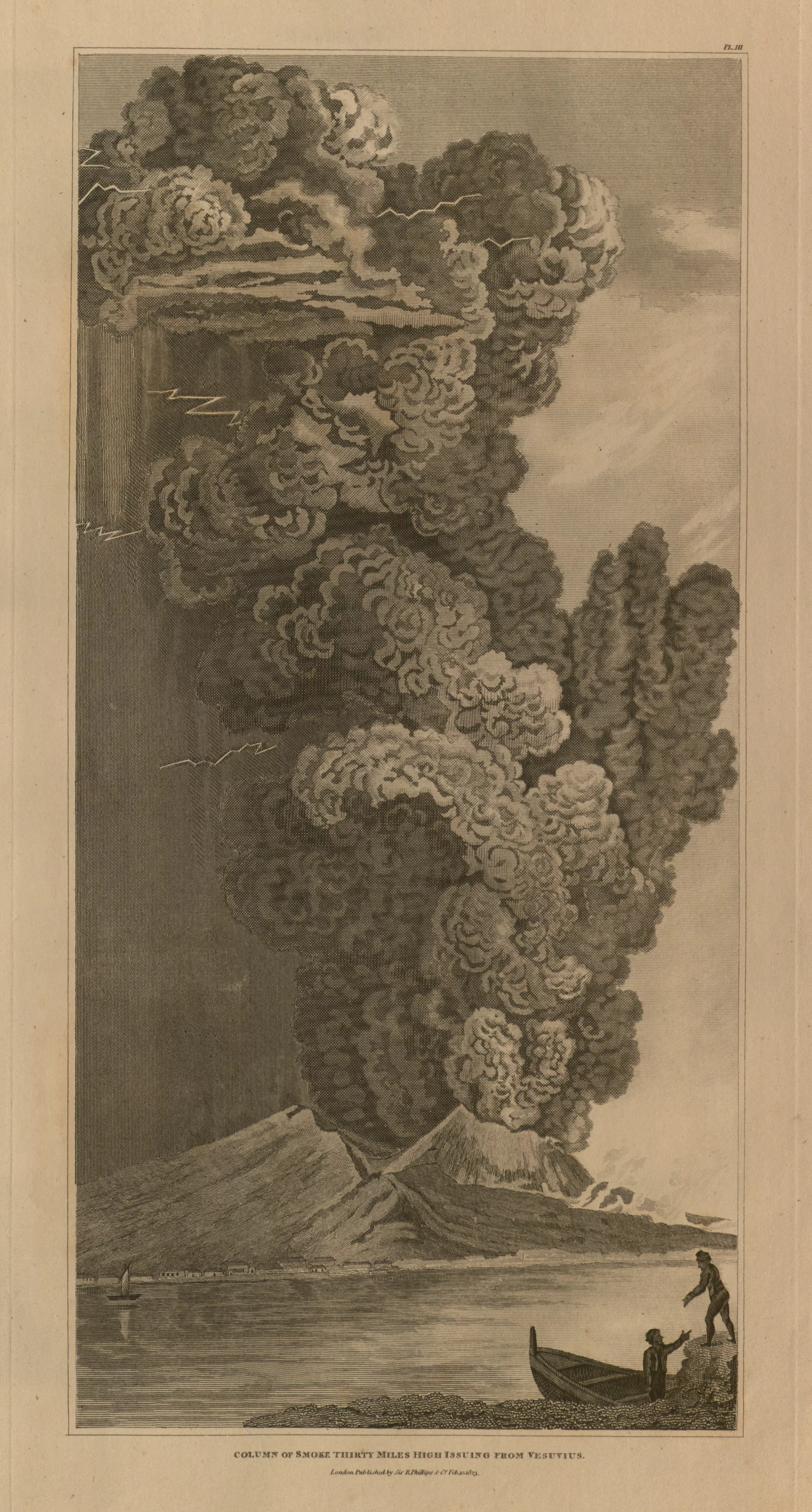Creation Date
1823
Height
39 cm
Width
20 cm
Medium
Genre
Description
Column of Smoke is a scientific illustration of an erupting volcano, drawn for the purpose of studying Mount Vesuvius. However, because scientific studies of volcanoes were still not taken seriously, this image went unappreciated for decades. In the early Romantic period, still during the late 1700s, the drawing was seen by many to be just another depiction of Mount Vesuvius as awe-inspiring and sublime. The image does feature characteristics that invoke the sublime—intimidating smoke, a tall volcano, and darting lightning. When the image was republished in 1823, however, it took on a new significance for Romantic culture. The Atlas of Nature valued the smoke for its visually-descriptive commentary on the atmosphere, and the image soon became popular in the scientific community. Consequently, the image is significant for two reasons: first, because it seemed (for an early Romantic audience) to portray the sublime, and second, because it was seen as scientifically descriptive by scientists of the late Romantic period.
Two dark figures stand near a canoe in the front right foreground. Far behind them is an empty town at the base of Mount Vesuvius. The volcano emits swirling grey smoke which covers the top three quarters of the engraving. Lightning bolts dart in various directions from the top layers of smoke. The left portion of the image is a mass of dense shadow, while to the right of the smoke column the sky is bright and a little cloudy; the smoke blocks the town from sunlight.
Column of Smoke Thirty Miles High Issuing From Vesuvius (1772) was acquired by William Hamilton from an unknown artist. The image, after being converted into an engraving, was sold to the British Museum. Both William Hamilton and Sir Richard Phillips published copies of this engraving. A copy was published by Sir Richard Phillips in the book Atlas of Nature in 1823. Atlas of Nature became part of Chester H. Thordarson’s private collection before arriving in Special Collections at the University of Wisconsin—Madison.
William Hamilton was a Scottish diplomat and lieutenant in the Scottish 3rd Foot Guards. He was soon promoted and sent to the Court of Naples to be Britain’s ambassador. While serving, Hamilton acquired Column of Smoke and made it into an engraving. The function of this image was to study Mount Vesuvius’ eruptions. He later sold this drawing and copies of his engravings to help support him financially. Later, Sir Richard Phillips included this image in Atlas of Nature for its scientific value. The depicted smoke rose thirty miles into the atmosphere, thus extending the theorized atmospheric height. This scientific aspect of the drawing was not fully appreciated until Phillip’s publication in 1823, when the study of volcanoes was more widespread.
Locations Description
Mount Vesuvius
Classified as a Stratovolcano (one with a tall, multi-layered cone), Mount Vesuvius rises to 4,203 feet (1,281 meters). Within the recent centuries, Vesuvius’ height has decreased due to massive eruptions which have destroyed the volcano’s walls. The volcano is located in the Province of Naples near Pompeii, the city destroyed by its eruption in 79 AD. Today Mount Vesuvius has two craters which emit magma. The larger cone is known locally as Palo. The second, newer cone—formed by massive amounts of magma hardening under pressure—is known as Monte Somma. After the 79 A.D. eruption Mount Vesuvius has erupted about twice every century, with no eruptions occurring after 1944 (S. Bisel Secrets of Vesuvius 2-64).
Court of Naples
This former legislative body of the Kingdom of Naples once invited ambassadors from across Europe to visit and study Mount Vesuvius. Since William Hamilton’s ambassadorship, the Kingdom of Naples has been replaced by the Kingdom of Two Sicilies and the Court of Naples subsequently dissolved (W. Sichel, Memoirs of Emma 435-436).
British Museum
Established in 1700, this museum collects and displays artworks concerned with human history and culture. The museum’s purchase of William Hamilton’s collection helped to financially support him (P. Harris, History of the British Museum 3).
3rd Foot Guards
Part of the Guards Division of the British Army, this regiment is assigned regularly to protect royal family members, usually those hailing from Scotland (F. Perridge, The History of Prince Alfred’s Guard).
Copyright
Copyright 2009, Department of Special Collections, Memorial Library, University of Wisconsin-Madison, Madison, WI
Publisher
Sir Richard Phillips
Collection
Accession Number
Thordarson T139
Additional Information
Bisel, Sara Louise Clark. Secrets of Vesuvius. New York, NY: Scholastic Inc., 1990.
Boulger, G. S. “Hamilton, William John (1805–1867).” Oxford Dictionary of National Biography. Ed. H. C. G. Matthew and Brian Harrison. Oxford: OUP, 2004. 2 Apr. 2009 http://www.oxforddnb.com/view/article/12146.
Harris, P. R. History of the British Museum, 1753-1973. London: British Library, 1998.
Mayer, Ralph. HarperCollins Dictionary of Art Terms and Techniques. New York, N.Y: HarperPerennial, 1991.
Perridge, Frank. The History of Prince Alfred’s Guard. Port Elizabeth: E. H. Walton & co., 1939.
Seccombe, Thomas. “Phillips, Sir Richard (1767–1840).” Oxford Dictionary of National Biography. Ed. H. C. G. Matthew and Brian Harrison. Oxford: OUP, 2004. Online ed. Ed. Lawrence Goldman. Jan. 2008. 2 Apr. 2009 http://www.oxforddnb.com/view/article/22167.
Sichel, Walter Sydney. Memoirs of Emma. New York: P. F. Collier & Son, 1910.

